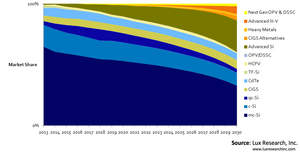BOSTON, MA--(Marketwired - Sep 24, 2013) - A look at disruptive solar innovations finds that technologies built around crystalline silicon (x-Si) modules are the most likely to find commercial success even though they won't meet the "SunShot" targets of $1/W installed set by the U.S. Department of Energy for 2020, according to Lux Research.
Today's installation prices are between two times and four times the SunShot targets of $1/W utility, $1.25/W commercial, and $1.50/W residential installation prices. Even in 2030, improvements will leave installation prices 13% above the targeted $1/W utility installation price.
"The most promising technologies are bifacial crystalline silicon modules, followed by tandem cell architectures for III-V and CIGS technologies -- these approaches will come closest to the target module costs and efficiencies by 2030," said Fatima Toor, Lux Research Analyst and the lead author of the report titled, "Continuing Education: Going Back to School for Photovoltaic Innovation." "Other technology families such as OPV/DSSC and heavy metals are likely to be farther away," she added.
Lux Research analysts compared disruptive technologies relative to the $1/W system price target and sorted them for their commercial feasibility, technology potential and expected market share by 2030. Among their findings:
- China leads in IP generation. Driven by the rise of leading Chinese solar manufacturers, such as Trina Solar and JA Solar, China in 2009 emerged as the highest IP generating country in the world, surpassing the U.S., while South Korea is at number three, followed by the European Union, Taiwan, and Japan.
- Lower VC funding is transforming innovation landscape. Venture capital funding for the industry has dried out -- from 86 deals at its 2008 peak to 34 in 2012 -- as many solar firms have struggled and failed. Now established corporations need to partner with academic and government institutions to access PV innovation.
- Five institutions dominate corporate partnerships. IMEC, ECN, Georgia Tech, University of Delaware, and Arizona State University account for 136 of the 940 corporate research partnerships Lux Research analyzed. IMEC led in tie-ups with chemicals and materials manufacturers, while ECN and Georgia Tech focused on materials suppliers and equipment manufacturers active in x-Si.
The report, titled "Continuing Education: Going Back to School for Photovoltaic Innovation," is part of the Lux Research Solar Components Intelligence service.
About Lux Research
Lux Research provides strategic advice and ongoing intelligence for emerging technologies. Leaders in business, finance and government rely on us to help them make informed strategic decisions. Through our unique research approach focused on primary research and our extensive global network, we deliver insight, connections and competitive advantage to our clients. Visit www.luxresearchinc.com for more information.
Contact Information:
Contact:
Carole Jacques
Lux Research, Inc.
617-502-5314
carole.jacques@luxresearchinc.com
